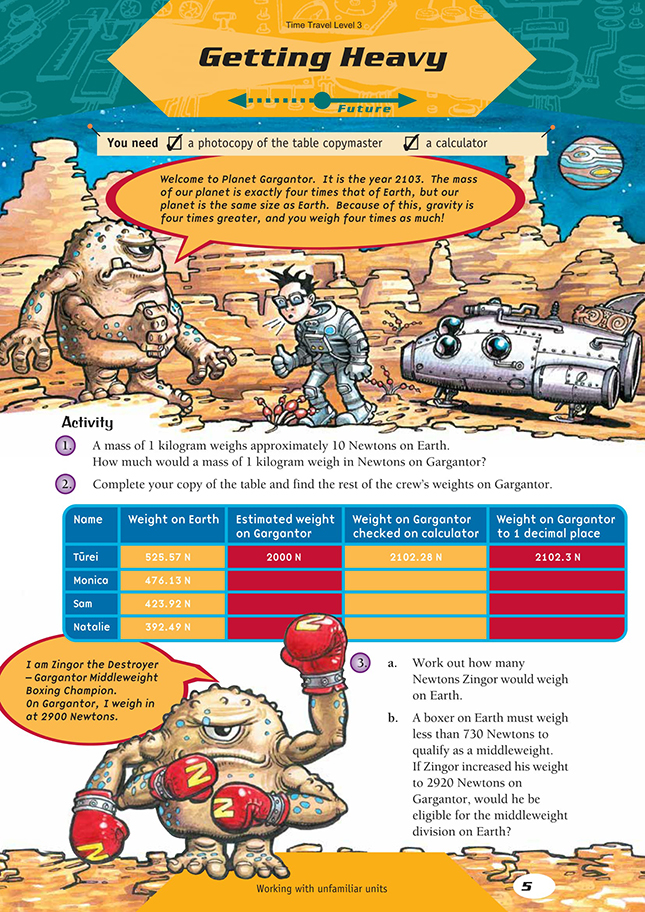This is a level 3 number activity from the Figure It Out theme series.
Click on the image to enlarge it. Click again to close. Download PDF (398 KB)
multiply by 2000 and check on a calculator
Photocopy of the table copymaster
FIO, Level 3, Theme: Time Travel, Getting Heavy, page 5
A calculator
In this activity, the students estimate, round, and multiply numbers within a context of weights differing because of different forces of gravity on Earth and on another planet.
The unit of measurement Newtons is used in this activity. In the English language, we talk about a person weighing 40 kilograms. Although we accept it and use this way of speaking quite freely, it is not scientifically correct. Kilograms are a measure of mass. Newtons are a measure of weight. Newtons are named after Sir Isaac Newton, who first discovered the laws of forces and gravity.
The body material of a person (bones, flesh, blood, and so on) has what is called mass. Mass is a measure of the amount of material a body has. It is measured in kilograms. Somebody with a mass of 60 kilograms has more body material than somebody with a mass of 50 kilograms. So what is weight? We are all kept on Earth by a force due to gravity. Gravity affects everything. However, the more mass an object has, the greater the force must be to keep it on Earth. So if we look at the
two people of 60 kilograms and 50 kilograms, a greater force is needed to keep the 60 kilogram person in place. This force can be roughly calculated using the formula:
Weight (force) = mass x 10
So the gravitational force holding the 60 kilogram person on Earth is 60 x 10 = 600 Newtons. The 50 kilogram person is held by 50 x 10 = 500 Newtons, weight being a force that acts on a mass. That’s why, strictly speaking, weight should be measured in Newtons, not kilograms.
What happens when the Space Waka crew go to Gargantor? That planet has a mass four times that of Earth, so the gravitational force that the Space Waka crew experience is four times greater than Earth’s. So the crew weighs four times as much on that planet as they would on Earth, but their mass is exactly the same.
Pages 17, 106, and 120–122 of Making Better Sense of the Physical World (Ministry of Education, 1999) contain useful information about forces and weights.
The students may use a variety of different strategies to complete the calculations for question 2. Discuss the idea of rounding numbers to the nearest 10 or to the nearest 100 to estimate weights on Gargantor. Some students may round to the nearest five, which is also acceptable. A number line may help the students to work out which number is best to round to:
476.13 is closer to 500 than it is to 400.
The students then need to multiply the rounded numbers by 4 to estimate the crew’s weights on Gargantor.
Some students may have difficulty rounding the answer they obtain on a calculator to one decimal place. Once again, the process of rounding can be modelled most effectively on a number line, for example:
1904.52 is closer to 1904.5 than it is to 1904.6.
For question 2, you will need to discuss strategies for finding a quarter of an amount. Those students who have difficulties finding a quarter of Zingor’s weight might find it easier to halve his weight and then halve it again to find a quarter. Once again, this can be modelled on a number line to show the students a visual model of the relative size of the numbers, for example:
The students might use a multiplicative strategy using known facts, for example,
of 2900 = 2900 ÷ 4
I know that 7 x 4 = 28, so 700 x 4 = 2800, and 20 x 4 = 80, and 5 x 4 = 20, so,
2900 = 2800 + 80 + 20
= (700 x 4) + (20 x 4) + (5 x 4)
So it follows that 2900 ÷ 4 = 725 (that is, seven hundreds, twenty tens, and five ones).
It is important to show the links between multiplication and division and for students to use the facts that they know to calculate the unknown.
In question 3b, the boxer must weigh less than 730 Newtons, which means that he will not qualify if he weighs exactly or more than 730 Newtons.
Here are several possible extension activities:
• The students could use a computer spreadsheet to multiply the Earth weights of objects by four and then round to one decimal place.
• The students could investigate weights of objects on a planet that is the same size as Earth but that has a mass exactly one-third that of Earth’s mass.
• Sir Isaac Newton developed mathematical laws for gravity. The students could research Sir Isaac Newton by using the Internet or a library.
Answers to Activities
1. 40 Newtons
2.
3. a. 725 N
b. No, as he would weigh exactly 730 N, and he must weigh less than 730 N to
qualify as a middleweight




